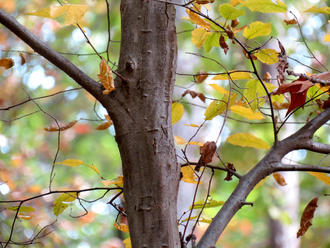American Hornbeam (Carpinus caroliniana Walter)
Also known as musclewood, blue beech, blue-beech, ironwood.
↑Summary
A small tree typically found in the understory of moist deciduous woodlands.
↑Range - Expand
| Legend | Color |
| Native | |
| Native or Not Present |
This tentative map is based on our own research. It may have limited data on Canada and/or Mexico, and there is some subjectivity in our assignment of plants as introduced vs. expanded. Read more in this blog post.
Although this plant occurs somewhere in each of these regions, it may only occur in a small part of some or all of them.
↑Habitat
Found in the understory of mature deciduous forests on moist sites, mostly in bottomlands, including wooded streambanks and well-drained swamp margins, also in shady ravines, east- and north-facing slopes. Occasional on uplands, mostly on locally moist sites such as near seeps.
Prefers light to moderate shade, moist but well-drained conditions, and a loamy soil high in organic matter.
↑Life Cycle
A slow-growing but long-lived understory tree.
Seed production usually starts at 15 years of age, peaks between 25 and 50 years, and continues to about 75 years. Large seed crops are produced roughly every 3-5 years. Wind blows the seeds a short distance, but they are primarily distributed by birds.
Seeds germinate from April to June, following a period of cold dormancy. Seedlings establish best in rich, loamy soil in conditions that are consistently moist and protected. Seedlings can establish well in thick leaf litter and heavy shade. Mortality among seedlings is high, often from flooding, but also from drought or herbivory. Seedlings are unlikely to survive if they are too close to an adult tree of their own species.
Although seedlings are highly shade-tolerant, adult trees are slightly less so and can get out-competed in the long-run by more shade-tolerant trees such as sugar maple or American holly. This species relies on creation of canopy gaps to reach maturity, although the increase in light required for such growth is only slight.
Lifespan is typically around 100 years but occasionally to 150 years.
↑Links & External Resources
• American Hornbeam | The Wood Database (About This Site)
• American Hornbeam | Fire Effects Information System (FEIS) (About This Site)
• Carpinus caroliniana (Musclewood) | Illinois Wildflowers (About This Site)
• Carpinus caroliniana (American Hornbeam) | USDA PLANTS Database (About This Site)
• Carpinus caroliniana | Go Botany (About This Site)
• Carpinus caroliniana (American Hornbeam) | Missouri Botanical Garden Plant Finder (About This Site)
• Hornbeam | Virginia Tech Dendrology Factsheets (About This Site)
• American Hombearn | Silvics of North America (About This Site)
• Carpinus caroliniana | Biota of North America Project (BONAP) (About This Site)
• Carpinus caroliniana | NatureServe Explorer (About This Site)
• Carpinus caroliniana | Flora of North America (About This Site)
• American Hornbeam | Maryland Biodiversity Project (About This Site)
• Carpinus caroliniana Walt. (American Hornbeam, Ironwood) | Digital Atlas of the Virginia Flora (About This Site)




